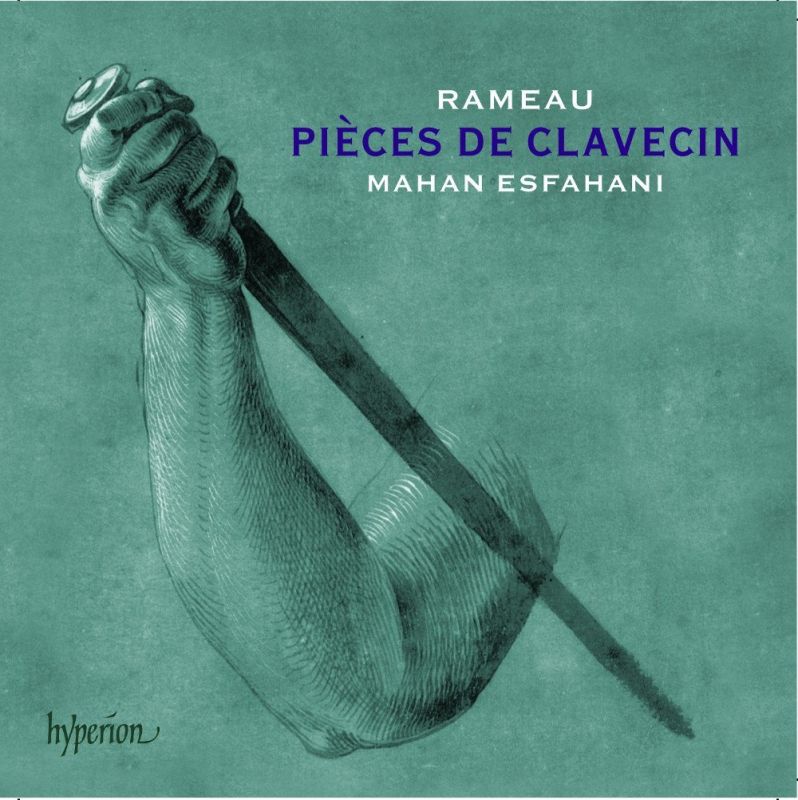RAMEAU Pièces de Clavecin
View record and artist detailsRecord and Artist Details
Composer or Director: Jean-Philippe Rameau
Genre:
Instrumental
Label: Hyperion
Magazine Review Date: 12/2014
Media Format: CD or Download
Media Runtime: 128
Mastering:
DDD
Catalogue Number: CDA68071-2

Tracks:
| Composition | Artist Credit |
|---|---|
| Pièces de clavecin, Movement: Suite no 1 in A minor |
Jean-Philippe Rameau, Composer
Jean-Philippe Rameau, Composer Mahan Esfahani, Harpsichord |
| Pièces de clavecin, Movement: Suite in E minor |
Jean-Philippe Rameau, Composer
Jean-Philippe Rameau, Composer Mahan Esfahani, Harpsichord |
| Pièces de clavecin, Movement: Suite in D major |
Jean-Philippe Rameau, Composer
Jean-Philippe Rameau, Composer Mahan Esfahani, Harpsichord |
| Pièces de clavecin, Movement: Menuet en rondeau |
Jean-Philippe Rameau, Composer
Jean-Philippe Rameau, Composer Mahan Esfahani, Harpsichord |
| Pièces de clavecin, Movement: Suite no 2 in A minor |
Jean-Philippe Rameau, Composer
Jean-Philippe Rameau, Composer Mahan Esfahani, Harpsichord |
| Pièces de clavecin, Movement: Suite in G minor |
Jean-Philippe Rameau, Composer
Jean-Philippe Rameau, Composer Mahan Esfahani, Harpsichord |
| Pièces de clavecin, Movement: La Dauphine (1747) |
Jean-Philippe Rameau, Composer
Jean-Philippe Rameau, Composer Mahan Esfahani, Harpsichord |
| Pièces de clavecin, Movement: Les petits marteaux |
Jean-Philippe Rameau, Composer
Jean-Philippe Rameau, Composer Mahan Esfahani, Harpsichord |
Author: Julie Anne Sadie
Some of the finest harpsichordists of our day have celebrated Rameau’s 250th anniversary with versions of his highly regarded if relatively little-known solo and concerted harpsichord works: highly innovative music for supremely accomplished practitioners. Among the recordings is something for nearly everyone, including those who prefer a Steinway to a Ruckers.
The choices of instrument and recorded sound quality produce the most immediate impressions. Esfahani and Haas play Ruckers in 18th-century states; Haas also uses a 1707 Dumont for the later books. Bruno Procopio plays a Ruckers copy, Ketil Haugsand a two-manual instrument he built himself; Julien Wolfs (Les Timbres) plays a 1751 Hemsch associated with Rameau’s patron, La Pouplinière. Thérèse Dussaut opted mainly for Steinways in her reissued recordings from the 1970s and early ’80s. Esfahani, Procopio and Dussaut favour a softer-edged, intimate recorded sound (you hear the gentle clatter of the Cobbe Collection’s Ruckers/Hemsch), while Haas and Hausgand prefer a brighter one. The extent to which the harpsichordists exploit the potential of their instruments is equally striking: among the soloists, Esfahani, Haas and Procopio make frequent and imaginative changes of manual, stops and coupling; Haugsand is relatively sparing.
Thérèse Dussaut’s highly controlled approach to the piano is little short of emasculating, both to the instrument and the music. Hers is the sound of a gilded music box, skewed to highlight the themes and almost completely devoid of resonance in the lower register; her added application of diminuendo is also indefensible. If her affection for Rameau’s music and the technique required to perform it are not in doubt, the relevance today of these recordings can be questioned.
However, a key factor in determining the longevity of an interpretation is the degree to which the performer succeeds in characterising the music and, on this point alone, top marks must go to Mahan Esfahani, who seems always to have its measure and brings unfailing wit, affection, fluency and pacing to his interpretations. The others share many of these qualities, but not all. Arthur Haas thinks on a microcosmic scale: everything is consciously worked out and beautifully crafted but rarely spontaneous; his penchant for shaping every line with inégalité often works against the insouciance he may be trying to project. Ketil Haugsand’s interpretations seem sombre; and because he too often chooses to linger on the first of a group of notes belonging to a beat or motif, he reduces its effect to cliché. Specific examples abound of the stylistic differences between these performances but nowhere more decisively than in the pieces of Rameau’s third book.
There is much of interest, too, in the two latest recordings of Rameau’s Pièces de clavecin en concerts (1741). This is uniquely constructed music for ensembles of soloists and both groups acquit themselves well. The bass viol part is exceptionally demanding, so Myriam Rignol plays an instrument fitted with an extra (8th) high G string (a copy of a mid-18th-century French instrument), the more easily to traverse Rameau’s frequent leaps between treble and bass. Les Timbres is a trio of flute, bass viol and harpsichord – one of the most delicate and refined of Baroque textures and one of Rameau’s preferred combinations for this collection. They play with charm but not always panache, allowing tempi occasionally to falter. Recognising that some movements and even sections suit the violin more than the flute and vice versa, Bruno Procopio and his colleagues have developed semi-orchestrated performances more varied and colourful than usual. Most importantly, their performances are richly characterised and reliably paced.
Of all the harpsichordists reviewed here, only Haugsand chose to record Rameau’s arrangements for solo harpsichord included in the 1741 collection (he made a fine recording of the concerted version with Catherine Mackintosh and Laurence Dreyfus in 1992). Esfahani considers the harpsichord arrangements to be ‘rather clunky nods to the publishing market’ and to my mind none approaches the finesse of the earlier Pièces de clavecin.
Having just won a Gramophone Award for his superlative CPE Bach recording, Esfahani has surely trumped it with Rameau’s solo harpsichord works.
Discover the world's largest classical music catalogue with Presto Music.

Gramophone Digital Club
- Digital Edition
- Digital Archive
- Reviews Database
- Full website access
From £8.75 / month
Subscribe
Gramophone Full Club
- Print Edition
- Digital Edition
- Digital Archive
- Reviews Database
- Full website access
From £11.00 / month
Subscribe
If you are a library, university or other organisation that would be interested in an institutional subscription to Gramophone please click here for further information.




